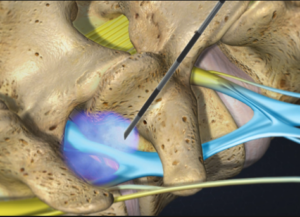30 Jun Procedure Spotlight: Epidural Steroid Injection (ESI)
 Back and neck pain are common. While sometimes aches and pains are normal, chronic or severe pain is not. This can be caused by a variety of conditions and injuries. However, if you suffer from certain conditions affecting the spinal cord, an epidural steroid injection may help.
Back and neck pain are common. While sometimes aches and pains are normal, chronic or severe pain is not. This can be caused by a variety of conditions and injuries. However, if you suffer from certain conditions affecting the spinal cord, an epidural steroid injection may help.
WHAT IS AN EPIDURAL STEROID INJECTION?
An Epidural Steroid Injection (ESI) is a common procedure. This minimally invasive injection treats pain and swelling around the spinal cord. The injection reduces pain by injecting steroid medication and sometimes anesthetics.
The epidural space is the outermost part of the spinal canal, located outside the dural membrane. This fat-filled area sits between the bone and the spinal nerves. Corticosteroid medicaiton and anesthetics are injected directly into this space to reduce swelling and pain.
WHO IS A CANDIDATE?
Patients with neck, arm, lower back or leg pain may benefit from epidural steroid injections. A variety of conditions may cause pain, but some respond better to injections. In addition, epidurals may ease pain enough so patients may continue physical therapy when symptoms interfere with rehabilitative exercises. Specifically, patients with the following painful inflammatory conditions may benefit most from the procedure:
- Spinal stenosis: narrowing of the spaces within the spine, often causing nerve pressure.
- Spondylolysis: type of “wear and tear” arthritis affecting the spine.
- Herniated disc: when part of the spinal disc is pushed out, sometimes causing pinched nerves.
- Degenerative disc: wearing away of the spinal discs, usually in older age, that causes pain and weakness.
- Sciatica: pain that radiates down the sciatic nerve from the lower back through the hips and buttocks, usually caused by herniated discs or bone spurs.
- Bone spurs: growth of bones that usually occurs in joints and can cause pressure on nerves and usually develops from osteoarthritis.
WHAT ARE THE BENEFITS?
Epidural steroid injections work by injecting steroid medication and anesthetics directly into the painful area. The injection may reduce pain and swelling in and around the spinal nerve roots, as well as around damaged nerves. The effects can last several months. Damaged nerves may also heal in time.
WHAT TO EXPECT DURING AN ESI?
At the Pain Management Group, our board-certified and fellowship-trained anesthesiologists perform these injections. The procedure may take about 20 minutes to an hour. You will lay on an x-ray table for the injection. The team will clean and numb the area for injection. Because the goal is to inject medication as close to the painful area as possible, your doctor will use imaging guidance with fluoroscopy (real-time x-ray) to help them place the needle in exactly the right location. This helps ensure patients receive maximum benefit from the injection.
Once they place the needle, your doctor will inject the medication into the epidural space. The provider then removes the needle and bandages the injection site. Patients may be sore for a few days. Usually, epidural steroid injections begin working in about two to seven days from injection. Most patients are able to walk immediately after an epidural steroid injection.
ARE THE INJECTIONS SAFE?
Epidural steroid injections and common and proven treatments for back and neck pain. It generally has very few associated complications and effective for most patients. As with any injection, there is a slight risk of infection and bleeding at the injection site. If you are on blood thinning medications, be sure to talk to your doctor prior to your injection. For more information or to schedule your pain assessment, please call 615.941.8538.
 For more information on The Pain Management Group, please visit thepainmanagementgroup.com or schedule an appointment at one of our locations throughout Middle Tennessee.
For more information on The Pain Management Group, please visit thepainmanagementgroup.com or schedule an appointment at one of our locations throughout Middle Tennessee.
We are committed to providing individualized care and vow to treat each patient with compassion and respect, never turning anyone away. Our physicians are fellowship-trained pain specialists who utilize a combination of interventional procedures and medication management services to tailor a personalized care plan for each patient’s long-term pain relief.





